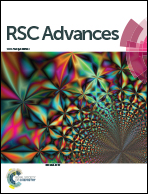Synthesis and characterization of a novel fluorinated bismaleimide via a nucleophilic addition–elimination reaction and its polymeric networks†
Abstract
The commercially available octafluorocyclopentene (OFCP) as both a fluorinated building block and a linker has been successfully utilized to prepare a new fluorinated bismaleimide monomer OFCP-BMI via a nucleophilic addition–elimination reaction. The resulting OFCP-BMI is characterized by 1H, 13C, 19F nuclear magnetic resonance (NMR) spectroscopy, attenuated total reflectance Fourier transform infrared spectroscopy (ATR-FTIR), and high resolution mass spectrometry. The monomer OFCP-BMI reacts with a free radical initiator or self-cures to prepare its resins. No obvious glass transition temperature (Tg) below 260 °C was observed for the self-curing resin suggesting that a highly cross-linked polymeric network was formed. The self-curing resin exhibits excellent thermal stability with the on-set weight loss temperature (Ton-setd) of 445 °C and a 50% char yield at 800 °C under a nitrogen atmosphere. The resin obtained by a free radical polymerization process exhibits less thermal stability and a lower char yield than the self-curing resin due to its lower cross-linking density. The self-curing resin exhibits a low dielectric constant (Dk = 2.5).


 Please wait while we load your content...
Please wait while we load your content...